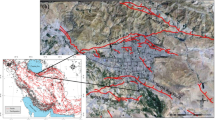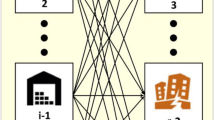Abstract
Effective relief reduces damages and protects people during natural disasters, such as earthquakes. This research proposes a data-driven model based on sustainability, taking into account the pre and post-crisis simultaneously. Real data was used to validate the model in various earthquake scenarios. The study addresses questions regarding the amount and allocation of relief goods during earthquakes. This research is carried out in two phases: simulation and modeling. The purpose of the simulation phase is to estimate the number of relief goods in different scenarios. Additionally, in the modeling phase, a data-based multi-objective model is presented, considering sustainability, to minimize the lack of relief goods, the number of untreated wounded, and supply chain costs. Using the dynamic simulation system, and after designing the structure of the earthquake effects on urban infrastructure, the actions and effects of the earthquake on vital arteries are investigated in different scenarios, and scenarios with a higher degree of risk are identified. The results showed that the highest and lowest demands for relief goods were related to the “Mosha-day fault” and “North Tehran-night fault” scenarios, respectively.















Similar content being viewed by others
Data availability
Majority of the data were presented in this manuscript. Additional raw data may be made available upon request.
References
Agarwal S, Kant R, Shankar R (2021) Humanitarian supply chain management: modeling the pre and post-disaster relief operations. Int J Disaster Resilience Built Environ 13(4):421–439
Ahmadi SA, Mirlohi SM, Ahmadi MH, Ameri M (2021) Portfolio optimization of power plants by using renewable energy in Iran. Int J Low-Carbon Technol 16(2):463–475
Benmokhtar A, Benouar D, Rahmoune A (2020) Modeling the propagation of the effects of a disturbance in a critical infrastructure system to increase its resilience. Urban Arhitectura Constructii 11(2):157–178
Boroumand A, Nojavan M, Mohammaditabar D, Ghaemi R (2022) A fuzzy inference system for predicting relief goods demand in the different scenarios of occurrence earthquake. Int J Nonlinear Anal Appl 13(2):651–671
Choukolaei HA, Rezaee MJ, Yousefi S, Saberi M (2022) A simulation-based approach for decision-making in earthquake crisis management. In Multi-Criteria Decision Analysis. CRC Press, pp 281–302
Choukolaei HA, Ghasemi P, Goodarzian F (2023) Evaluating the efficiency of relief centers in disaster and epidemic conditions using multi-criteria decision-making methods and GIS: a case study. Int J Disaster Risk Reduct 85:103512
Coburn A, Spence R (2002) Earthquake protection. John Wiley & Sons
Coburn AW, Spence RJS, Pomonis A (1992) Factors determining human casualty levels in earthquakes: mortality prediction in building collapse. In Proceedings of the tenth world conference on earthquake engineering, vol 10. Balkema Rotterdam, pp 5989–5994
Dobrzański P, Dobrzańska M (2018) Computer simulation of warehouse processes using the Enterprise Dynamics software. AUTOBUSY-Technika Eksploatacja Systemy Transportowe 19(6):1026–1029
Dong L, Bai Y, Xu Q, Mas E (2022) Optimizing the post-disaster resource allocation with Q-Learning: Demonstration of 2021 China flood. International Conference on Database and Expert Systems Applications. Springer International Publishing, Cham, pp 256–262
Esteghamati MZ, Farzampour A (2020) Probabilistic seismic performance and loss evaluation of a multi-story steel building equipped with butterfly-shaped fuses. J Constr Steel Res 172:106187
Esteghamati MZ, Flint MM (2023) Do all roads lead to Rome? A comparison of knowledge-based, data-driven, and physics-based surrogate models for performance-based early design. Eng Struct 286:116098
Firuzi E, Ansari A, Amini Hosseini K, Rashidabadi M (2019) Probabilistic earthquake loss model for residential buildings in Tehran, Iran to quantify annualized earthquake loss. Bull Earthq Eng 17:2383–2406
Ghasemi P, Khalili-Damghani K, Hafezalkotob A, Raissi S (2020) Stochastic optimization model for distribution and evacuation planning (a case study of Tehran earthquake). Socioecon Plan Sci 71:100745
Ghasemi P, Khalili HA, Chobar AP, Safavi S, Hejri FM (2022) A new multiechelon mathematical modeling for pre-and postdisaster blood supply chain: robust optimization approach. Discrete Dynamics in Nature and Society 2022, pp 1–10
Halverson R (2006) Simulation with enterprise dynamics® software: tutorial presentation. J Comput Sci Coll 21(4):161–161
Hwang SH, Mangalathu S, Shin J, Jeon JS (2022) Estimation of economic seismic loss of steel moment-frame buildings using a machine learning algorithm. Eng Struct 254:113877
Ibrion M, Mokhtari M, Nadim F (2015) Earthquake disaster risk reduction in Iran: Lessons and “lessons learned” from three large earthquake disasters—Tabas 1978, Rudbar 1990, and Bam 2003. Int J Disaster Risk Sci 6(4):415–427
Imperatives S (1987) Report of the world commission on environment and development: Our common future. Accessed Feb 10(42,427)
Jain S, Bharti KK (2023) A combinatorial optimization model for post-disaster emergency resource allocation using meta-heuristics. Soft Comput 27(18):13595–13611
JICA (2000) The study on seismic micro zoning of the greater Tehran area in the Islamic Republic of Iran. Pacific Consultants International Report, OYO Cooperation, Japan, 291–390
Kalakonas P, Silva V (2022) Earthquake scenarios for building portfolios using artificial neural networks: part I—ground motion modelling. Bulletin of Earthquake Engineering, pp 1–22
Khan SM, Shafi I, Butt WH, Diez IDLT, Flores MAL, Galán JC, Ashraf I (2023) A systematic review of disaster management systems: approaches, challenges, and future directions. Land 12(8):1514
Khojasteh G, Rezaee MJ, Chakrabortty RK, Saberi M (2024) Bayesian network based on cross bow-tie to analyze differential effects of internal and external risks on sustainable supply chain. In Computational Intelligence Techniques for Sustainable Supply Chain Management (Chapter 12). Elsevier Inc. https://doi.org/10.1016/B978-0-443-18464-2.00005-4
Kuhlman T, Farrington J (2010) What is sustainability? Sustainability 2(11):3436–3448
Li T, Xie N, Zeng C, Zhou W, Zheng L, Jiang Y, Yang Y, Ha HY, Xue W, Huang Y, Chen SC (2017) Data-driven techniques in disaster information management. ACM Comput Surv (CSUR) 50(1):1–45
Montáns FJ, Chinesta F, Gómez-Bombarelli R, Kutz JN (2019) Data-driven modeling and learning in science and engineering. Comptes Rendus Mécanique 347(11):845–855
Norouzian-Maleki P, Izadbakhsh H, Saberi M, Hussain O, Jahangoshai Rezaee M, GhanbarTehrani N (2022) An integrated approach to system dynamics and data envelopment analysis for determining efficient policies and forecasting travel demand in an urban transport system. Transp Lett 14(2):157–173
Omoya M, Ero I, Zaker Esteghamati M, Burton HV, Brandenberg S, Sun H, Yi Z, Kang H, Nweke CC (2022) A relational database to support post-earthquake building damage and recovery assessment. Earthq Spectr 38(2):1549–1569
Riga E, Karatzetzou A, Apostolaki S, Crowley H, Pitilakis K (2021) Verification of seismic risk models using observed damages from past earthquake events. Bull Earthq Eng 19(2):713–744
Rooeinfar R, Raissi S, Ghezavati VR (2019) Stochastic flexible flow shop scheduling problem with limited buffers and fixed interval preventive maintenance: a hybrid approach of simulation and metaheuristic algorithms. Simulation 95(6):509–528
Sabouhi F, Tavakoli ZS, Bozorgi-Amiri A, Sheu JB (2019) A robust possibilistic programming multi-objective model for locating transfer points and shelters in disaster relief. Transportmetrica A: Transp Sci 15(2):326–353
Shaw L, Das SK, Roy SK (2022) Location-allocation problem for resource distribution under uncertainty in disaster relief operations. Socio-Econ Plan Sci 82:101232
Shin Y, Kim S, Moon I (2019) Simultaneous evacuation and entrance planning in complex building based on dynamic network flows. Appl Math Model 73:545–562
Tavakoli B, Favakoli A (1993) Estimating the vulnerability and loss functions of residential buildings. Nat Hazards 7:155–171
Vega JA, Hidalgo CA (2016) Quantitative risk assessment of landslides triggered by earthquakes and rainfall based on direct costs of urban buildings. Geomorphology 15(237):217–235
Williams E, Szakmany T, Spernaes I, Muthuswamy B, Holborn P (2020) Discrete-event simulation modeling of critical care flow: new hospital, old challenges. Crit Care Explor 2(9):e0174
Yousefi S, Jahangoshai Rezaee M, Moradi A (2020) Causal effect analysis of logistics processes risks in manufacturing industries using sequential multi-stage fuzzy cognitive map: a case study. Int J Comput Integr Manuf 33(10–11):1055–1075
Author information
Authors and Affiliations
Contributions
Hassan Ahmadi Choukolaei: methodology, software, formal analysis, visualization, writing—original draft; Mustafa Jahangoshai Rezaee: supervision, conceptualization, methodology, validation, review and editing; Peiman Ghasemi: conceptualization, investigation, supervision, methodology, formal analysis, validation, writing—original draft; Morteza Saberi: investigation, supervision, review and editing.
Corresponding author
Ethics declarations
Ethical approval
This article does not contain any studies with human participants or animals performed by any of the authors.
Consent to participate
Not applicable.
Consent for publication
Not applicable.
Conflict of interest
The authors declare no competing interests.
Additional information
Responsible Editor: Philippe Garrigues
Publisher's Note
Springer Nature remains neutral with regard to jurisdictional claims in published maps and institutional affiliations.
Rights and permissions
Springer Nature or its licensor (e.g. a society or other partner) holds exclusive rights to this article under a publishing agreement with the author(s) or other rightsholder(s); author self-archiving of the accepted manuscript version of this article is solely governed by the terms of such publishing agreement and applicable law.
About this article
Cite this article
Ahmadi Choukolaei, H., Jahangoshai Rezaee, M. & Ghasemi, P. Data-driven modeling using system dynamics simulation to provide relief in earthquake based on different scenarios. Environ Sci Pollut Res 31, 35266–35282 (2024). https://doi.org/10.1007/s11356-024-33490-9
Received:
Accepted:
Published:
Issue Date:
DOI: https://doi.org/10.1007/s11356-024-33490-9




